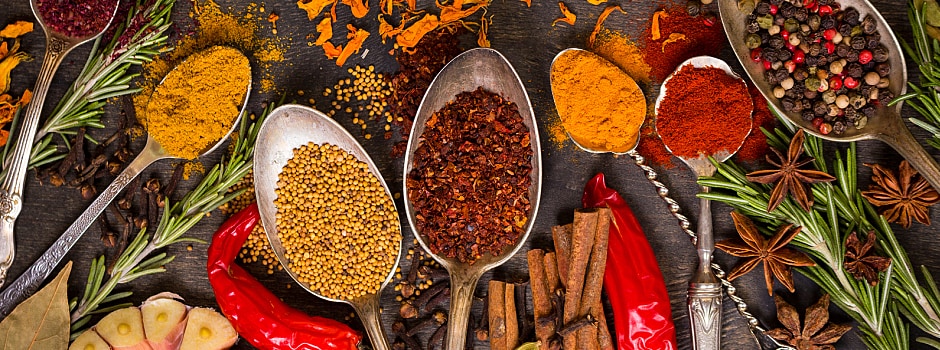Spices and spice blends are perfect for amplifying the flavor of your restaurant's dishes and drinks in order to leave a lasting impression on your guests' palates. Every year, there are new trendy spices and blends. Chipotle chilies had their chapter, hibiscus had its heyday, and thyme had its moment. But what's it going to be this time around?
Keep reading to find out which spices are expected to be make an impact on the restaurant scene in 2017.
Individual Spices in the Spotlight
Turmeric
Turmeric is a root that's in the same family as ginger, and is more known for its gorgeous, golden glow than its bitter flavor. In India, the spice has long been used to substitute for the color of saffron, and it's actually responsible for giving yellow mustard its signature shade. Turmeric has long been lauded for its nutritional benefits, but soon, it's going to be making an impression on your drinks and dipping sauces.
You'll be seeing turmeric turn up in cocktail recipes from top mixologists, such as this recipe, which features lavender and turmeric honey syrup. You'll also find pinches of it in creamy sauces, which will entice eaters to dip sweet potato fries and other crispy delights into its golden goodness.
Mace
Mace is another spice that's making a big splash (OK, pinch) on the culinary scene. After Mace was chosen as the name of one of NYC's top cocktail bars (where you'll find it in the form of a mist sprayed on top of the bar's eponymous drink), the spice has been surfacing in both sweet and savory dishes.
You'll often find mace, which is derived from the aril, or seed coating, of nutmeg, in fall desserts like pumpkin and sweet potato pie, but it can also be used in meat and vegetable dishes. Try using it in Indian- and Greek-inspired dishes, and add it into your mulled wine if you plan on serving it when the weather is cold.
Ras El Hanout: A Spice Blend Set to Trend
This heavily aromatic Middle Eastern spice blend is one that no two spice shops make the same way. That's because the name translates to "head of the shop," and it's considered to be each spice store's best spice blend.
You'll typically find the same players in almost every ras el hanout: cumin, coriander, clove, cinnamon, mace, nutmeg, turmeric, cinnamon, cardamom, peppercorns, and paprika. Whichever spices you choose to use, you can expect to impress diners with this aromatic and flavorful mix. Try using ras el hanout in Moroccan- and Middle Eastern-inspired stews, tagines, and other meat and vegetable dishes.
Where to Find High-Quality Spice Blends
You can find plenty of restaurant-quality spices, spice blends, and rubs in custom and bulk quantities online. A few great places to start are Penzeys Spices and The Spice House, which are related but both offer unique items, as well as Whole Spice, which is based in Napa, California, and offers more than 600 spices and blends. These companies produce remarkable spice blends that you can source (or attempt to mimic) to use in your dishes.
If you don't feel like waiting for an online order to arrive, head over to your local supermarket and you'll find a vast selection of specialty spices that can satisfy your need for instant gratification. You may not find ras el hanout, but you can probably find everything you'll need to create your own unique version.
Related Articles

5 Reasons Quality Cocktail Ingredients Are a Must
High-quality cocktail ingredients make all the difference when distinguishing average bartenders from mixologists. Here are five reasons not to skimp.

Spice Up Fall with Easy Seasonal Cocktail Ideas
Seasonal ingredients aren’t just for your dinner menu—surprise your customers by bringing cold-weather flavors behind the bar.

10 Infusions to Flavor Liqueurs
Take your craft cocktails to the next level by infusing liqueurs with herbs, spices, flowers, and fruit.
